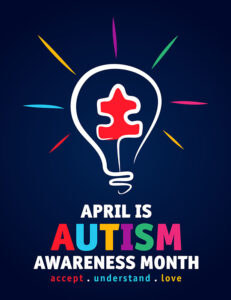Autism now affects 1 in 36 U.S. children, up from the 1 in 44 reported in 2021. Why?
By Deborah Jeanne Sergeant
 If it seems like you hear about autism spectrum disorder more than you used to, you’re not imagining things.
If it seems like you hear about autism spectrum disorder more than you used to, you’re not imagining things.
The Centers for Disease Control and Prevention reports that the prevalence has increased from 1 in 44 US children to 1 in 36.
Andy Shih, chief science officer at Autism Speaks in New York City, said the perceived increase in prevalence reflects progress in awareness, as well as earlier identification and diagnosis.
“More people have become aware of the signs of autism and the tools that can assist in identifying it, the more compelled they are to seek an official diagnosis,” Shih said. “While the prevalence increase is an indication of progress in certain aspects, it also reiterates the need for increased funding for autism research and services throughout the lifespan and spectrum and a need for earlier screenings as the average age of diagnosis in the U.S. is still 4 to 5 years old when we know that autism can be reliably diagnosed by 18 months to 2 years.”
Screening at the pediatrician’s office can help identify more children who would benefit from intervention.
Autism Speaks offers tools to address these needs, including the M-CHAT checklist. This screening list poses a series of questions for toddlers to help identify signs of autism and assess whether they may need further evaluation. Shih also said that the World Health Organization’s virtual Caregivers Skill Training Program, developed in collaboration with Autism Speaks, provides a self-guided platform to teach caregivers therapies and services skills that can foster the development of their child.
“Intentional, targeted outreach, as well as training culturally informed service providers can also make a difference in delivering accessible quality care to the growing number of children with autism, especially in underserved communities,” Shih said.
The Autism Speaks Autism Care Network forms a partnership among 20 participating medical centers across the U.S. and Canada and uses patient insights to improve person and family-centered autism care.
A seeming increase in prevalence of autism may seem like an alarming trend. However, it’s a positive move, according to physician Emily Knight, Ph.D., developmental behavioral pediatrician, assistant professor of pediatrics and neuroscience at URMC.
“It allows us to find more children with autism which is a good thing because we can connect more children with supports that are needed,” Knight said. “We hope we’re missing fewer children who we could benefit from these services. We do see that we’re catching some groups in the population that were missed before with socio-economic disadvantage who had less access to services. There’s still work to be done but these disparities are getting better.”
She theorizes that some children were previously missed because the presentation of autism can be subtle and its traits can mimic other causes.
“With increased awareness of how the whole variety of how the spectrum looks, more providers are able to recognize those signs, even if they aren’t as clear,” Knight said. “Screening is recommended for all children, even when there are no signs of autism, at least at two of the well-child checks at 18, 24 and 30 months and any time a parent raises a concern.”
Autism By the Numbers
From the Centers for Disease Control and Prevention:
• About 1 in 36 children has been identified with autism spectrum disorder according to estimates from CDC’s Autism and Developmental Disabilities Monitoring Network.
• ASD is reported to occur in all racial, ethnic and socioeconomic groups.
• ASD is nearly four times more common among boys than among girls.
• About one in six (17%) children aged 3–17 years were diagnosed with a developmental disability, as reported by parents, during a study period of 2009-2017. These included autism, attention-deficit/hyperactivity disorder, blindness and cerebral palsy, among others.

